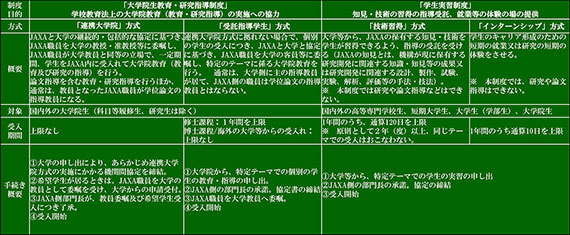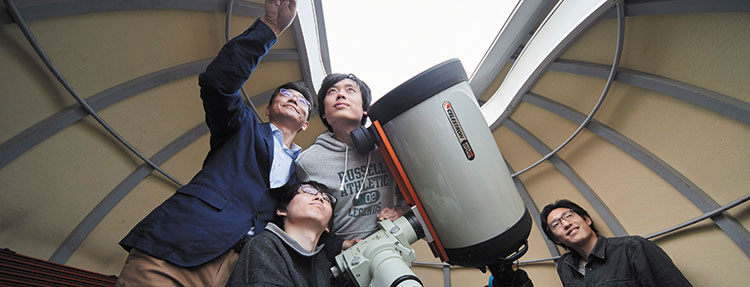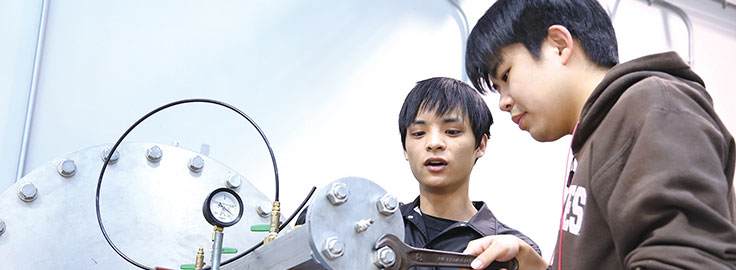Aerospace
In
Our University Initiatives
Promoting space-focused research
In recent years, private spacecraft have been put into practical use in the United States, and people who are not astronauts have more opportunities to go into space. From now on, space development will become more and more familiar to us. Aoyama Gakuin University College of Science and Engineering and Graduate School of Science and Engineering are actively conducting research and education in the aerospace field.
 Utilizing the collaborative graduate school system to provide students with a wide range of research fields
Utilizing the collaborative graduate school system to provide students with a wide range of research fields
Professor, College of Science and Engineering Department of Mechanical Engineering, Dean College of Science and Engineering, Dean of Graduate School of Science and Engineering
Hideo Naga
Aoyama Gakuin University Graduate School Graduate School of Science and Engineering Completed the doctoral program in the Department of Mechanical Engineering. Ph.D. (Engineering) (Aoyama Gakuin University). After working as an assistant at the Department of Mechanical Engineering, College of Science and Engineering, Tohoku University, and College of Science and Engineering Department of Mechanical Engineering at Tohoku University, he became an associate professor at Waseda University College of Science and Engineering Department of Mechanical Engineering in 2007 and became a professor in 2013. He has served as the College of Science and Engineering Dean of the University and the Graduate School of Science and Engineering of the Graduate School.
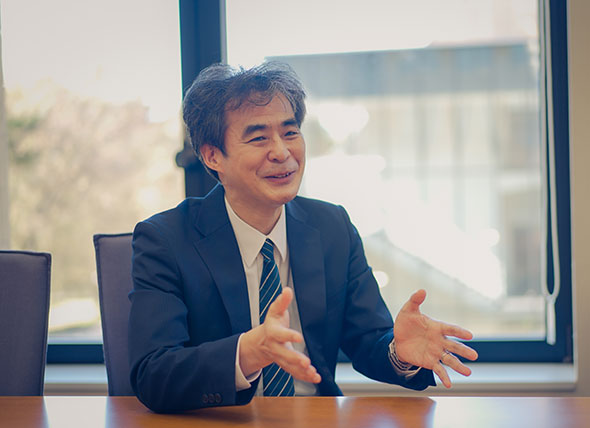
Space is one of the major themes representing science, and it gives many people dreams. Many students' eyes light up when they hear about space. Our university's College of Science and Engineering is made up of seven departments, and students can study a wide range of academic fields, from science such as mathematics and physics to management and systems engineering, which has a social science perspective. Two of these departments, Department of Physical Sciences and Department of Mechanical Engineering have faculty and students working on space and aviation research.
Space is one of the major themes in physics, and three faculty members in Department of Physical Sciences are conducting research based on theory and observation. Meanwhile, Department of Mechanical Engineering focuses on making and controlling things. Manufacturing is the foundation that supports various industries. Even in the aerospace field, knowledge of mechanical engineering is required when making aircraft and spacecraft. In Department of Mechanical Engineering, faculty members who are researching mechanical dynamics and materials engineering are also involved in the aerospace field.
There are many different approaches to the aerospace field. In our university, not only can we study the universe itself in Department of Physical Sciences, but we can also study space and aviation through machines and materials. The wide range of options available is a major strength of the Faculty of College of Science and Engineering, as we can get involved in areas that suit each student's interests.
Our university collaborates with other universities and research institutes in various ways. In the aerospace field, we have signed a graduate school collaboration agreement with the Japan Aerospace Exploration Agency (JAXA), and graduate students who wish to do so conduct research at JAXA. The graduate school collaboration is a framework in which our students are accepted into JAXA laboratories and their research is supervised by JAXA researchers (faculty members). Of course, since the students are affiliated with our university, we collaborate with our faculty members to support them.
Unlike large national universities, our Faculty of Science College of Science and Engineering cannot cover all fields. However, by having outside experts supervise students' research at our affiliated graduate school, we are able to provide a wider range of research to our students.
I think that being able to receive direct guidance from JAXA researchers will also motivate students. Sagamihara Campus, where College of Science and Engineering is located, is located very close to the JAXA Institute of Space and Astronautical Science. This makes it easy to travel between the two campuses, and has the advantage of making it very easy to collaborate and conduct joint research.
Department of Physical Sciences offers a class called "Latest Physics Lectures" for third-year students. In this class, we invite JAXA researchers who are visiting professors at the affiliated graduate school and external lecturers to give lectures. Listening to talks about various research topics will give you an opportunity to think about your graduation research and future career paths. We want students to choose their research topic and career path based on their own interests and concerns.
Overview of the "Collaboration Graduate School System"
(From the Japan Aerospace Exploration Agency's "New JAXA Student Acceptance System")
◆What is the “Partner Graduate School System”?
Based on a continuous and comprehensive agreement between JAXA and a university, JAXA researchers are commissioned to serve as professors or associate professors at universities, and the commissioned JAXA researchers are in a position equivalent to that of university faculty, accepting students for a certain period of time at JAXA to provide graduate education (education and research guidance). In addition to providing education and research guidance, including thesis guidance, the JAXA researchers who have become faculty members usually become the supervisors for doctoral dissertations.
◆Who are the eligible students?
Graduate students enrolled in a graduate school that has a collaborative graduate school agreement with JAXA in Japan or overseas.
* Excluding course students and research students
◆What scope of instruction can you provide?
This is education and research guidance (graduate school education), including thesis guidance.
◆ "Maximum period of stay at the organization"
This is the period required for education and research guidance.
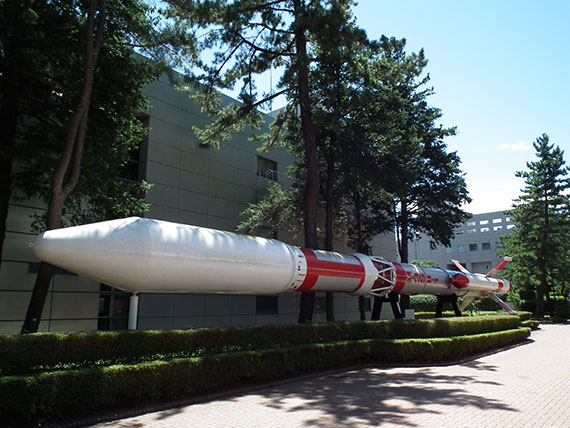
JAXA Institute of Space and Astronautical Science Sagamihara Campus
 Initiatives in the field of astrophysics
Initiatives in the field of astrophysics
Professor, College of Science and Engineering Department of Physical Sciences
Takanori Sakamoto
Completed his doctoral course Graduate School of Science and Engineering. PhD (Science) (Tokyo Institute of Technology). After working as a collaborative researcher at the Makishima Space Radiation Laboratory at the RIKEN Institute, a NASA Postdoctoral Program Fellow, and a Research Associate at the University of Maryland Baltimore County, he was appointed assistant professor in the Department of Physics and Mathematics at the Faculty College of Science and Engineering and Engineering, Aoyama Gakuin University in 2012, and became a professor in 2019.
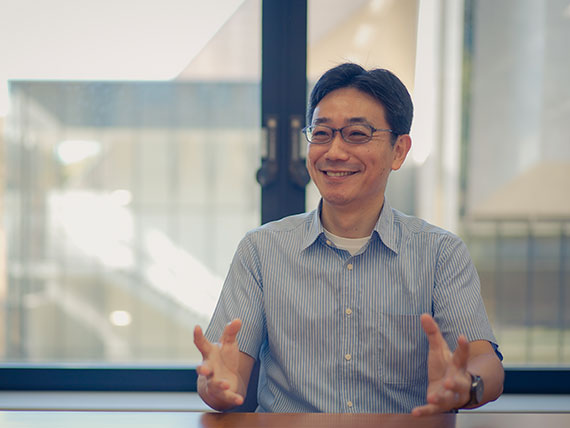
Physics is broadly divided into theory and observational/experimental research, and these two fields influence each other as they advance in science. Department of Physical Sciences has three laboratories related to astrophysics, and students can choose to conduct both theoretical and observational research.
In theoretical research, we use theoretical models that we construct to predict phenomena observed from celestial bodies, etc. In observational research, on the other hand, we accumulate new knowledge by developing new observational equipment, actually observing celestial bodies, and analyzing the obtained data to limit theoretical predictions.
I specialize in observing celestial bodies using short-wavelength electromagnetic waves such as X-rays and gamma rays. In the collaborative graduate school program with JAXA, one student each from my laboratory and that of Professor Atsumasa Yoshida, who is also conducting observational research, are sent to Professor Tetsuya Yoshida's laboratory at JAXA. Professor Tetsuya Yoshida is promoting an internationally joint balloon experiment orbiting Antarctica with the aim of searching for antiparticles and antimatter in cosmic rays originating from dark matter, which is thought to fill the universe.
Currently, I am launching and operating the ultra-small rapid reporting demonstration satellite ARICA, and the idea for this satellite came to me when I heard that Professor Tetsuya Yoshida was using private sector communication equipment in his balloon experiments. The collaborative graduate school system not only broadens the students' own research fields, but also my horizons as a teacher, providing an opportunity to generate new ideas.
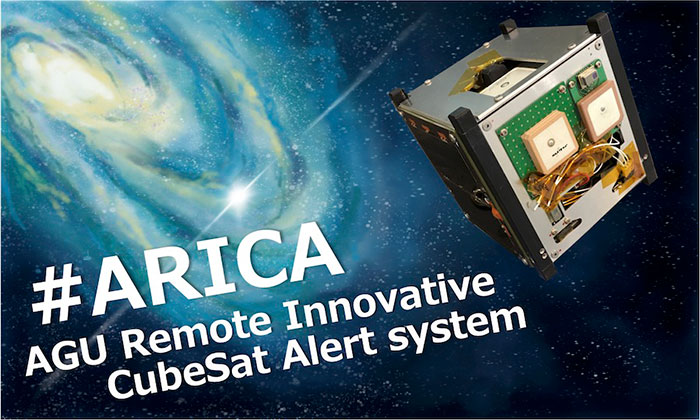
ARICA: Ultra-small Rapid Report Demonstration Satellite
In addition to sending students to Professor Yoshida Tetsuya's laboratory through the Collaborative Graduate School Program, we are also conducting a number of research projects in collaboration with JAXA. ARICA is a 10cm cubesat, a microsatellite, that was selected as one of the demonstration themes for JAXA's Innovative Satellite Technology Demonstration No. 2 and was launched on Tuesday, November 9, 2021, aboard JAXA's small solid rocket Epsilon No. 5.
Although CubeSats can be made at universities, there are limited ways to transport them into space. When the production costs for ARICA were in sight, there was no time to think concretely until the launch. Fortunately, at the same time, there was a public call for proposals for the Innovative Satellite Technology Demonstration No. 2, so we applied and were selected. ARICA is a satellite that was completed with student-led overall design, design of the boards to be installed, development of the satellite's power supply and control system around the sensors, development of the gamma ray detector, and development of the communication terminal control system. The selection meant that there was no room for delays in development, but thanks to the efforts of the students, after the satellite's thermal vacuum test at the JAXA Institute of Space and Astronautical Science facility in April 2021, and vibration and shock tests using the Kyushu Institute of Technology facility in May and July, we were able to hand over the satellite to the rocket in mid-August and successfully go into space. Students are also playing a central role in developing programs to visualize the data sent from the satellite and operating it after launch.
ARICA is a satellite to demonstrate technology for reporting gamma-ray bursts that occur suddenly in space. The satellite's reporting system will also be installed on Japan's own gamma-ray burst observation satellite, HiZ-GUNDAM. HiZ-GUNDAM is currently one of the candidate satellites for JAXA's public small satellite project. If it is selected, we will be involved with JAXA people more in the production and operation of the satellite.

Epsilon Rocket No. 5 (Uchinoura Space Center, Kimotsuki Town, Kagoshima Prefecture)
MOVIE
This is the first step towards unraveling the mystery of the birth of the universe.
Tuesday, November 9, 2021 ARICA goes into space!
Gamma-ray bursts can be used as bright light sources in the distant universe to explore the early state of the universe. The "ARICA Project" is a project led by students from the Sakamoto Laboratory, with the aim of demonstrating a new gamma-ray burst reporting system.
This is a documentary video that captures the journey of Professor Sakamoto and his laboratory members from just before the rocket launch until the day of the launch.
Sakamoto Laboratory Interview
Development of the ARICA Rapid Report Demonstration Satellite and
Looking back at the launch
Graduate Graduate School of Science and Engineering Department of Science and Engineering, Basic Science Course, 2nd year of Master's program
Yasuyo Hata
Faculty College of Science and Engineering, Department of Physics and Mathematics * 4 years
(*From the 2021 academic year, the Department of Physics and Mathematics will be reorganized as the Department of Physical Sciences and Department of Mathematical Sciences.)
Kazuma Kamoshida
ARICA was developed in the Sakamoto Laboratory and launched on the Epsilon Rocket No. 5. We will share the behind-the-scenes story of how the student-led project was developed and operated, along with the joy of the successful launch.
VIEW DETAILS →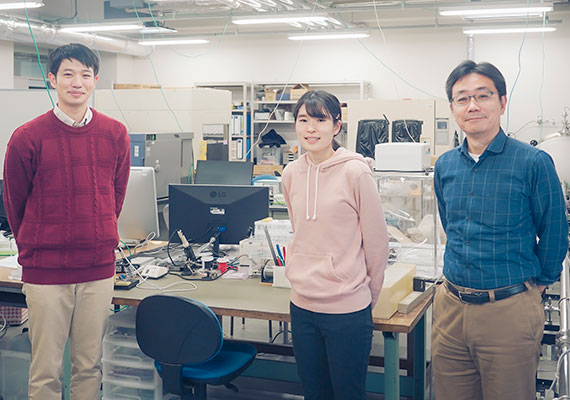
From sudden celestial events
Discover the dynamic universe
College of Science and Engineering
Professor Takanori Sakamoto
We will discuss the future of space observations, touching on the ARICA Rapid Report Demonstration Satellite, a technology demonstration project to observe violent astronomical phenomena such as gamma-ray bursts and supernova explosions that occur in space.
VIEW DETAILS →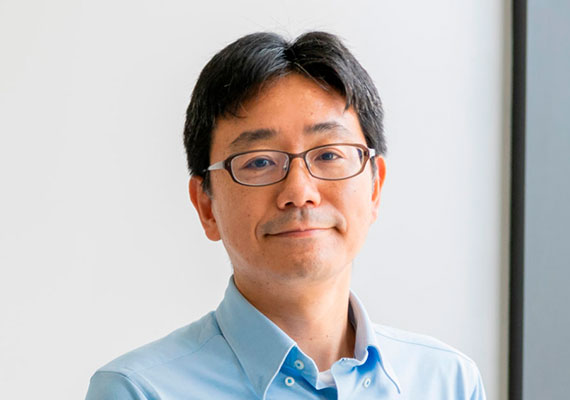
 Initiatives in the field of aerospace engineering
Initiatives in the field of aerospace engineering
Space Field
Associate Professor, College of Science and Engineering Department of Mechanical Engineering
Yoshiki Sugawara
D. in Electronic and Mechanical Engineering from Nagoya University. Doctor of Engineering (Nagoya University). After working as a researcher at the Higashi Osaka Space Development Cooperative, a researcher at the University of Tokyo Graduate School of Engineering, Department of Aerospace Engineering, Industry-Academia-Government Collaboration, Aoyama Gakuin University College of Science and Engineering Department of Mechanical Engineering assistant and assistant professor, and an associate professor at Akita University, Akita University, he was appointed as an College of Science and Engineering Department of Mechanical Engineering associate professor in 2016. He is currently an Associate Professor.

In my laboratory, we conduct research on developing high-precision control methods for robot arms used in space, landing systems for planetary landers, etc. Spacecraft that perform various operations in the space environment are difficult to test in advance in an environment identical to space.
In particular, my field of expertise, mechanical dynamics, is greatly affected by gravity. The movement of objects in space, where there is almost no gravity, is completely different from their movement on Earth, where there is gravity. On Earth, we can only conduct experiments that partially simulate the experience of space, such as drop experiments that last for a few seconds.
This is where verification through simulation becomes important. By recreating space on a computer and investigating how machines will move when operated there, experiments and tests on the ground can be carried out efficiently, reducing the development costs of spacecraft and enabling them to be developed in a short period of time.
In order to reproduce the movement of a machine more accurately in a simulation, it is necessary to create a mathematical model that expresses the movement in mathematical formulas. Mathematical models are also very important when considering how to control the machine so that it moves as desired. For this reason, we build mathematical models based on kinematics and dynamics, analyze them through simulation, and develop control methods.
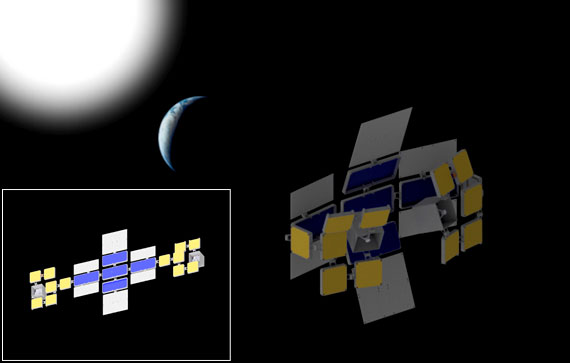
A "Transformer spacecraft" that can transform to perform various functions. On the right is the observation mode, and on the left is the fully deployed mode.
My lab also sends graduate students to JAXA to conduct research under Professor Mori Osamu through the collaborative graduate school system. The graduate students are involved in academic research in space engineering while tackling practical issues such as developing spacecraft that will actually be launched by JAXA and operating them after launch.
In the Cooperative Graduate School Program, the graduate students' supervisor will be Professor Mori Osamu. Although the Cooperative Graduate School Program is aimed at graduate students, in order to make the most of their graduate school research, it is important to start preparations from the fourth year of undergraduate studies. Therefore, we have created a situation where undergraduate students can receive technical guidance from JAXA professors from their fourth year of undergraduate studies under the technical acquisition method that is also available to undergraduate students.
In addition, our laboratory is participating in the research activities of the JAXA Space Engineering Committee Working Group "Research on the Realization and Application of Transformer Spacecraft." A transformer spacecraft is a vehicle that can change shape in space to achieve a variety of functions. We are currently conducting research and development in collaboration with various groups, including JAXA. We plan to conduct an in-orbit demonstration using a small robot that will serve as a demonstration vehicle in the early 2020s, and are currently developing the robot for that purpose.

A microgravity experiment using a small robot with technology required for the Transformer spacecraft, conducted at the drop tower testing facility in Hokkaido (March 2021)
Aviation sector
Associate Professor, College of Science and Engineering Department of Mechanical Engineering
Shota Hasunuma
Completed his doctoral course at the Graduate School of Engineering, The University of Tokyo. PhD (Engineering) (The University of Tokyo). After working in the Manufacturing Department of the Industrial Equipment Company at Fuji Heavy Industries Ltd. and as a visiting researcher and assistant professor in the Department Department of Mechanical Engineering, Faculty of College of Science and Engineering Technology, at our university, he was appointed associate professor in 2020, a position he holds to this day. He also serves as a lecturer for the "Fatigue Design Seminar for Beginners" held by the Fatigue Division Committee of the Society for Materials Science, Japan.
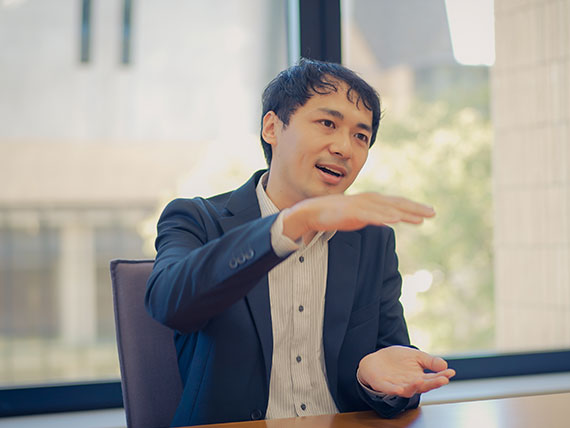
Both aircraft and spacecraft require a variety of materials to build their fuselages. Advances in materials make it possible to build lighter and stronger aircraft. In the real world, aircraft and spacecraft do not end with their construction. It is necessary to operate the aircraft safely. My specialty, material strength, studies the processes of strength, fracture, and deformation of materials, and accumulates knowledge to prevent accidents involving aircraft, spacecraft, and various other machines.
My laboratory studies material strength science and has been collaborating with JAXA's laboratory for more than 20 years, including the time of my predecessor. College of Science and Engineering Before moving to the current Sagamihara campus, JAXA had a campus in Setagaya, and I believe that one of JAXA's predecessors, the National Aerospace Laboratory of Japan (now the "JAXA Chofu Aerospace Center"), was located nearby, which led to personal connections among researchers that led to our collaboration.
The fact that not only the Materials Strength Laboratory but also several other laboratories in College of Science and Engineering had connections with researchers at the National Aerospace Laboratory of Japan (NALJ) led to the graduate school collaboration with JAXA. Sagamihara Since the campus is close to the JAXA Institute of Space and Astronautical Science, we have been deepening our interactions not only with researchers at the JAXA Chofu Aerospace Center but also with those at the JAXA Institute of Space and Astronautical Science. In the graduate school's Mechanical Engineering Course, JAXA researchers are part-time lecturers in such courses as "Advanced Space Structural Materials Engineering" and "Advanced Aerospace Engineering.
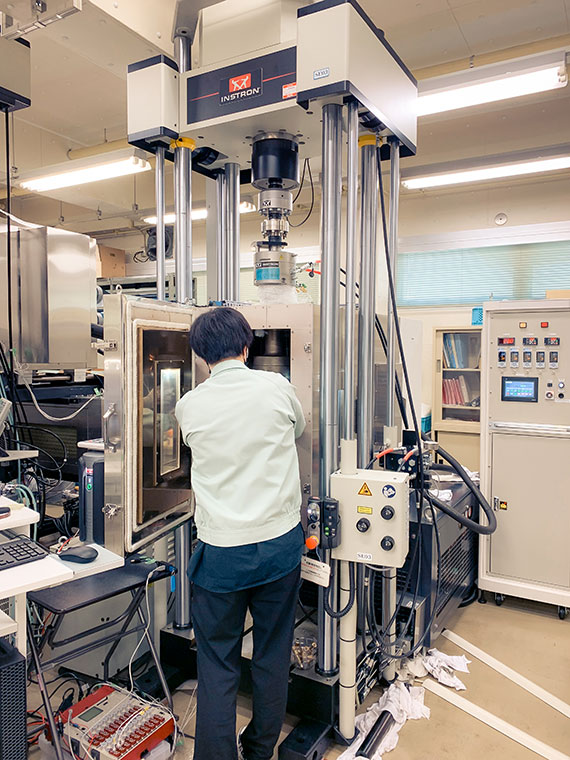
Graduate students from our university taking exams at JAXA
Four graduate students in the materials lab are conducting research at JAXA through JAXA's collaborative graduate school system. The Materials Strength Lab is collaborating with Professor Kumazawa Hisashi of JAXA. Professor Kumazawa's lab is conducting basic research into the use of carbon fiber reinforced plastics (CFRP) in liquid hydrogen tanks.
Current passenger aircraft are heavily dependent on fossil fuels, and the burden on the environment due to carbon dioxide emissions is becoming a problem. Liquid hydrogen is attracting attention as one of the fuels for next-generation aircraft, but it has a low boiling point of -252.6℃ and is more difficult to handle than fossil fuels. Professor Kumazawa Hisashi's laboratory is evaluating the strength and other properties of CFRP in cryogenic environments of -250 to -200℃.
Being exposed to cutting-edge aerospace research is a great stimulus for the students. I also get to learn about materials that are not the subject of my research, broadening my knowledge. Currently, I am conducting research into the evaluation of the properties of thermal barrier coatings for turbine blades used in jet engines, and the fatigue strength evaluation of welded parts of tanks for hybrid rockets. Hybrid rockets are attracting attention as a technology that can launch rockets safely and cheaply. I would be happy if I could contribute to the practical application and launch of hybrid rockets through my research into fatigue strength.

Professor Hisashi Kumazawa (left) of JAXA and students from the affiliated graduate school
Interview with Hasunuma Laboratory
Protecting people's lives and bringing about change in society
Material strength research
College of Science and Engineering Department of Mechanical Engineering / Graduate School of Science and Engineering Department of Science and Engineering, Mechanical Engineering Course, Laboratory of Materials Strength
Associate Professor Shota Hasunuma × Yuta Kato
Many materials are used in railways, aircraft, buildings, etc. In order for these materials to function to the fullest, the strength of the materials is important. We conduct research from this perspective.
VIEW DETAILS →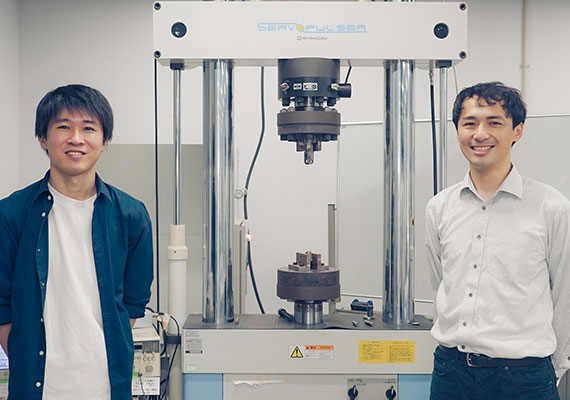
 Related Laboratories Pick UP (Links to each laboratory's website)
Related Laboratories Pick UP (Links to each laboratory's website)
astrophysical theory
Theoretical research in astrophysics (Ryo Yamazaki Laboratory)
◆ The moment a black hole is born, and the origin of gamma-ray bursts
◆ Clarification of celestial bodies emitting high-energy cosmic rays and high-energy gamma rays
◆ Reproducing space events on Earth: Laboratory astrophysics
Astrophysics Experiments
High Energy and Gravitational Wave Astronomy (Takayuki Sakamoto Laboratory)
Search for the electromagnetic counterpart of gravitational wave sources
Observational research
into high-energy transient objects
High Energy Astrophysics, Transient Object Research (Yoshida Atsumasa Laboratory)
◆ Observational research into celestial phenomena using artificial satellites and development of observation equipment
* Research into sudden astronomical phenomena based on observations in the X-ray and gamma-ray regions
Mechanical Control Research (Koji Sugawara Laboratory)
◆ Robot Dynamics and Control
◆ Spacecraft Dynamics and Control
◆ Multibody Dynamics
Analysis and control of
flexible structures
Material Strength Research (Shota Hasunuma Laboratory)
◆ Strength evaluation of materials for automobiles, motorcycles, and power plants
◆ Research on fatigue fracture and crack propagation
◆ Development of destruction simulation technology
◆ Material testing at the nano/micro scale
Jet Propulsion Research (Kazuhiko Yokota Laboratory)
◆ Aerospace engine flow
◆ Flow of aerospace vehicles
◆ Micro engine trends
Flow of
Micro Projectiles
Fluid
-related vibration and fluid-coupled vibration
Material Mechanics Research (Yoneyama Satoshi Laboratory)
Elucidation of the mechanical behavior of viscoelastic materials
◆ Stress and strain measurement using light and image processing
◆ Clarification of phenomena such as crack propagation and bending
◆ Measurement of the shape and displacement of actual structures such as bridges
◆ Evaluation of fracture mechanics parameters and plastic zone dimensions

